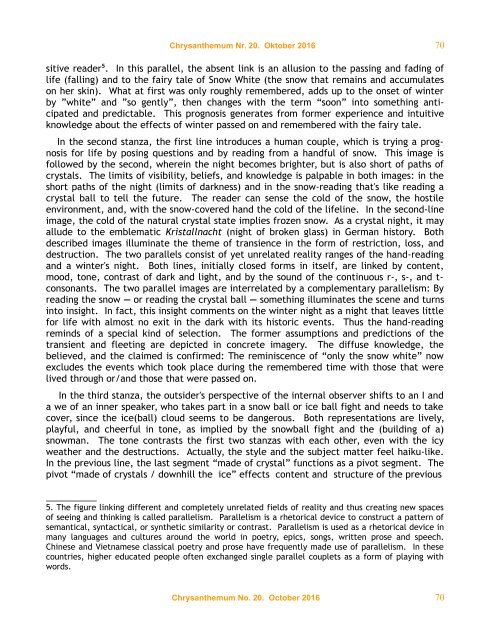Internet-Magazin Internet Magazine
1G26s1kkG
1G26s1kkG
Erfolgreiche ePaper selbst erstellen
Machen Sie aus Ihren PDF Publikationen ein blätterbares Flipbook mit unserer einzigartigen Google optimierten e-Paper Software.
Chrysanthemum Nr. 20. Oktober 2016 70<br />
sitive reader 5 . In this parallel, the absent link is an allusion to the passing and fading of<br />
life (falling) and to the fairy tale of Snow White (the snow that remains and accumulates<br />
on her skin). What at first was only roughly remembered, adds up to the onset of winter<br />
by ”white” and ”so gently”, then changes with the term “soon” into something anticipated<br />
and predictable. This prognosis generates from former experience and intuitive<br />
knowledge about the effects of winter passed on and remembered with the fairy tale.<br />
In the second stanza, the first line introduces a human couple, which is trying a prognosis<br />
for life by posing questions and by reading from a handful of snow. This image is<br />
followed by the second, wherein the night becomes brighter, but is also short of paths of<br />
crystals. The limits of visibility, beliefs, and knowledge is palpable in both images: in the<br />
short paths of the night (limits of darkness) and in the snow-reading that's like reading a<br />
crystal ball to tell the future. The reader can sense the cold of the snow, the hostile<br />
environment, and, with the snow-covered hand the cold of the lifeline. In the second-line<br />
image, the cold of the natural crystal state implies frozen snow. As a crystal night, it may<br />
allude to the emblematic Kristallnacht (night of broken glass) in German history. Both<br />
described images illuminate the theme of transience in the form of restriction, loss, and<br />
destruction. The two parallels consist of yet unrelated reality ranges of the hand-reading<br />
and a winter's night. Both lines, initially closed forms in itself, are linked by content,<br />
mood, tone, contrast of dark and light, and by the sound of the continuous r-, s-, and t-<br />
consonants. The two parallel images are interrelated by a complementary parallelism: By<br />
reading the snow — or reading the crystal ball — something illuminates the scene and turns<br />
into insight. In fact, this insight comments on the winter night as a night that leaves little<br />
for life with almost no exit in the dark with its historic events. Thus the hand-reading<br />
reminds of a special kind of selection. The former assumptions and predictions of the<br />
transient and fleeting are depicted in concrete imagery. The diffuse knowledge, the<br />
believed, and the claimed is confirmed: The reminiscence of “only the snow white” now<br />
excludes the events which took place during the remembered time with those that were<br />
lived through or/and those that were passed on.<br />
In the third stanza, the outsider's perspective of the internal observer shifts to an I and<br />
a we of an inner speaker, who takes part in a snow ball or ice ball fight and needs to take<br />
cover, since the ice(ball) cloud seems to be dangerous. Both representations are lively,<br />
playful, and cheerful in tone, as implied by the snowball fight and the (building of a)<br />
snowman. The tone contrasts the first two stanzas with each other, even with the icy<br />
weather and the destructions. Actually, the style and the subject matter feel haiku-like.<br />
In the previous line, the last segment “made of crystal” functions as a pivot segment. The<br />
pivot “made of crystals / downhill the ice” effects content and structure of the previous<br />
__________<br />
5. The figure linking different and completely unrelated fields of reality and thus creating new spaces<br />
of seeing and thinking is called parallelism. Parallelism is a rhetorical device to construct a pattern of<br />
semantical, syntactical, or synthetic similarity or contrast. Parallelism is used as a rhetorical device in<br />
many languages and cultures around the world in poetry, epics, songs, written prose and speech.<br />
Chinese and Vietnamese classical poetry and prose have frequently made use of parallelism. In these<br />
countries, higher educated people often exchanged single parallel couplets as a form of playing with<br />
words.<br />
Chrysanthemum No. 20. October 2016 70


